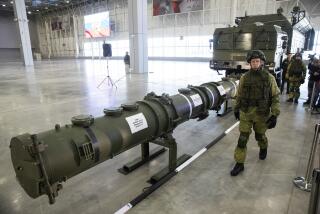U.S. Stance on ‘Stealth’ Missiles
- Share via
I take issue with Theodore Postol’s column “In Soviet Arms Talks, U.S. Takes Troubling Stance on ‘Stealth’ Missiles” (Opinion, Sept. 10). Postol’s thesis is that the Navy’s sea-launched cruise missile (SLCM) should be included in the Strategic Arms Reduction Talks (START). This is not consistent with U.S. national security goals.
The SLCM is an extremely flexible theater nuclear weapon, not a strategic or triad weapon. START negotiations would be complicated by their inclusion and progress toward an agreement delayed.
Like Postol, the Soviets would like to negotiate the elimination of the SLCM. Specifically, they propose a numerical limit on all nuclear-armed cruise missiles with ranges exceeding 600 kilometers, as well as a limitation of the kinds of ships which might carry such weapons. This proposal would place serious limits on our Tomahawk missiles, as well as one or two classes of longer-range Soviet land-attack cruise missiles now undergoing testing.
However, it would leave intact the bulk of Soviet short-range cruise missiles designed for attacking our aircraft carriers, which was the main reason the Soviets developed cruise missile technology in the first place. In addition, this proposal would dramatically reduce the favorable impact which cruise missiles have on stability by limiting their distribution.
The existence of the nuclear SLCM and dual capable (conventional/nuclear) tactical aircraft were key reasons why members of the Joint Chiefs of Staff were able to support the INF Treaty. Now the Soviets are trying to negotiate away both these essential offsets to their conventional superiority in Europe. Until the Soviets reduce their ground forces to a position of parity, we should not bargain away our tactical nuclear counter.
The SLCM, deployed on 200 ships and submarines, enhances deterrence by distributing nuclear capability. This causes the Soviets to spread their defenses, particularly their submarines, to attempt to defend against many targets.
The SLCM is also a necessary deterrent against Third World weapons of mass destruction. The proliferation of chemical, biological and nuclear weapons and long-range delivery systems make it essential that we have a credible deterrent--forward deployed--that cannot be easily shot down by robust enemy air defenses.
C.A.H. TROST
Admiral, U.S. Navy
More to Read
Sign up for Essential California
The most important California stories and recommendations in your inbox every morning.
You may occasionally receive promotional content from the Los Angeles Times.













